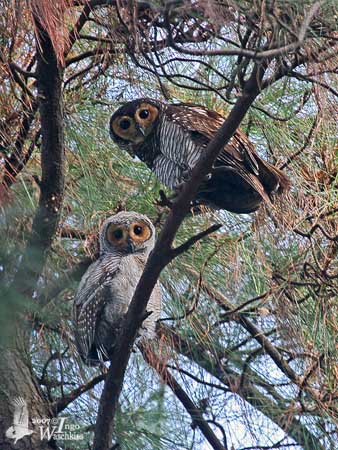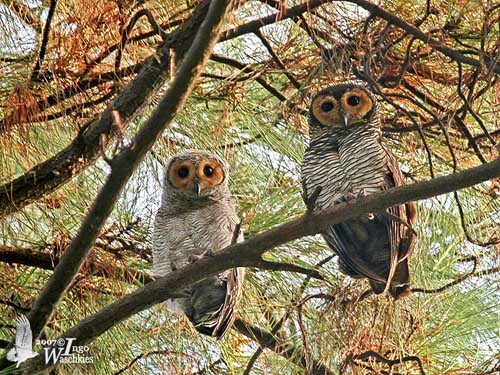
Fr: Chouette des pagodes
All : Pagodenkauz
Esp: Cárabo de las Pagodas
Ital : Allocco maculato asiatico
Nd: Maleise Bosuil
Sd: Fläckig skogsuggla
Photographer:
Ingo Waschkies
Bird Photography
Text by Nicole Bouglouan
Sources:
HANDBOOK OF THE BIRDS OF THE WORLD Vol 5 by Josep del Hoyo-Andrew Elliott-Jordi Sargatal - Lynx Edicions - ISBN: 8487334253
A photographic guide to Birds of Vietnam, Cambodia and Laos by Peter Davidson. New Holland Publishers. ISBN: 9781847731418
A Field Guide to the Birds of South-East Asia by Craig Robson. New Holland Publishers. ISBN: 9781780090498
BirdLife International (BirdLife International)
Spotted Wood-owl
Strix seloputo
Strigiforme Order – Strigidae Family
BIOMETRICS:
Length: 45-47 cm
Weight: Male : 1010 g
DESCRIPTION:
The Spotted Wood-owl belongs to the genus Strix including relatively large owls which frequent various forested habitats.
The adult has dark brown upperparts with reddish-brown lower back. Head and upper neck are darker, almost black. Numerous black-edged white spots cover the dorsal area, extending to the forecrown.
The upperwing-coverts are brown barred white, whereas scapulars are white with dark brown stripes.
On the underparts, the chin is buff. The throat is white with brown-edged feathers. Neck sides are barred white. The remaining underparts are white with reddish-brown tinge on the breast, all heavily barred dark.
On the head, the ear-tufts are absent. The facial disk is plain rusty.
The bill is greenish-black. The eyes are dark brown. The tarsi are feathered white with dark barring. The toes are grey.
Both sexes are similar.
The juvenile has white down finely barred dark.

We find three subspecies:
S.s. seloputo is found in S Myanmar and C Thailand S to Sumatra and Java.
S.s. baweana is found on Bawean Island, off N Java. This one is smaller and paler, with narrower barring on underparts.
S.s. wiepkeni is found on Calamian and Palawan Islands, in W Philippines. This one has yellowish-rufous ground-colour on the underparts.
VOICE: SOUNDS BY XENO-CANTO
The Spotted Wood-owl gives loud, deep, abrupt booming “WHO” or “UUH” repeated several times and often preceded by rolling “huhuhuhuhu”. It also produces loud, deep quavering “WRRRROOH, WRRRROOH, WRRRROOH…”
We can also hear resonant, rising “beloop” or “hoop-hoong”, and deep growling calls.
HABITAT:
The Spotted Wood-owl frequents the edges of evergreen forests and logged forests, plantations, wooded parks, orchards and open forest. It can be noted in ricefields, cultivated areas and sometimes mangroves and open deforested areas. It may be seen sometimes in the vicinity of water.
This species usually occurs below 800 metres, but sometimes up to 1000 metres of elevation.
RANGE:
See above in “subspecies”
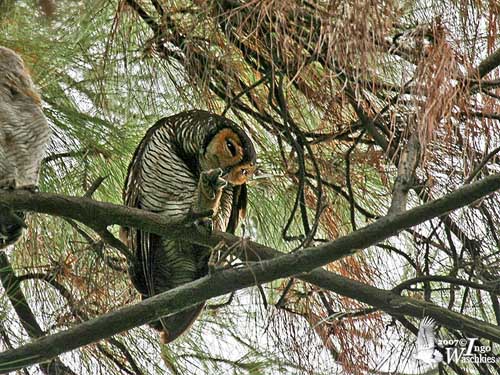
BEHAVIOUR:
The Spotted Wood-owl, as numerous Strigidae species, feeds mainly on small rodents, small birds and large insects. It may occasionally catch snakes and bats.
It usually hunts from perch, at 2-3 metres above the ground. It uses the most basic hunting style “sit-and-wait”. Once the prey is detected, it drops or glides from the perch and attacks the prey on the ground. This is the typical hunting behaviour of forest species. The prey is killed with the talons and a bite to the back of the skull.
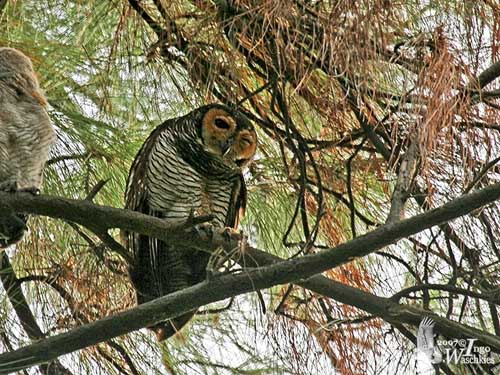
This species is usually alone or in pairs. It roosts in tall trees from where it calls.
The breeding behaviour is poorly known. However, some typical behaviour probably occurs such as vocalisations by the male to attract the female or renew the pair-bond with its mate. Courtship feeding by the male bringing preys to the female and accompanied by some displays or postures is usual in many owl’s species. Aerial displays and mutual preening are observed too.
The species is resident in its range.
FLIGHT:
The Spotted Wood-owl, as other owls, performs silent flight due to the peculiar feather pattern of the wings.
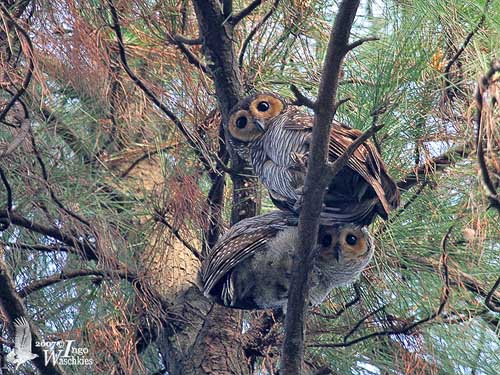
REPRODUCTION:
The breeding season takes place between January and June in Malay Peninsula. Young fledglings are visible from March to August.
The Spotted Wood-owl nests in tree-hollow, or sometimes in platform-like epiphytic fern in tree, between 2 and 18 metres above the ground. It may sometimes nest on top of other bird’s nest.
The female lays two white eggs, rarely three, directly on the floor of the nest without any lining.
Currently, there is no more information.
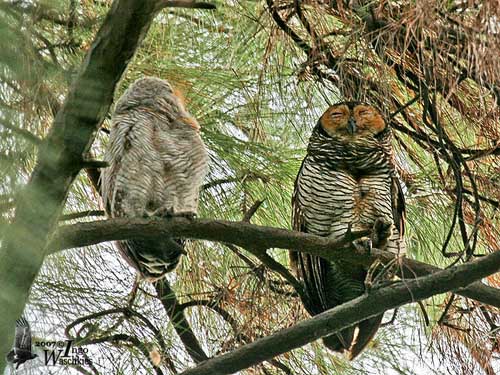
DIET:
The Spotted Wood-owl feeds mainly on small rodents, small birds and large insects. It may exceptionally take snakes and bats. It typically hunts from perch.
PROTECTION / THREATS / STATUS:
The Spotted Wood-owl can be common or uncommon according to the range. But due to the secretive habits of this bird, it is difficult to get right numbers. Populations appear stable in spite of disturbances and habitat loss which could become future problems for them.
But currently, this species is not globally threatened and occurs in several protected areas.
